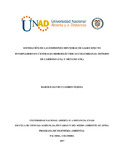Mostrar el registro sencillo del ítem
Estimación de las emisiones difusoras de gases efecto invernadero en centrales hidroeléctricas Colombianas: Dióxido de Carbono (CO2) y Metano (CH4).
| dc.contributor.advisor | Cuellar Álvarez, Yohen | |
| dc.coverage.spatial | cead_-_palmira | spa |
| dc.creator | Cuadros Tejeda, Harold David | |
| dc.date.accessioned | 2017-11-14T14:58:22Z | |
| dc.date.available | 2017-11-14T14:58:22Z | |
| dc.date.created | 2017-06-01 | |
| dc.identifier.uri | https://repository.unad.edu.co/handle/10596/13762 | |
| dc.description.abstract | Teniendo en cuenta los diferentes estudios desarrollados principalmente en América del Sur sobre emisiones atmosféricas producidas por reservorios, se determina que las centrales hidroeléctricas emiten gases efecto invernadero (GEI) a la atmósfera (de Lucena, Schaeffer, & Szklo, 2010; Demarty & Bastien, 2011; Rocha Lessa, dos Santos, Lewis Maddock, & Santos Bezerra, 2015; Soito & Freitas, 2011; Weisser, 2007; Yang et al., 2014; Zhang et al., 2015), que tienen incidencia sobre el calentamiento global y el cambio climático. De este modo, por medio de la metodología aportada por el panel intergubernamental para el cambio climático sobre la estimación de emisiones de gases de efecto invernadero provenientes de tierras convertidas en tierras permanentemente inundadas IPCC(2006), se estimaron las emisiones difusoras de dióxido de carbono (CO2) y metano (CH4) producidas por los principales embalses de las centrales hidroeléctricas en Colombia, generando valores de emisión, comparando las emisiones calculadas entre las hidroeléctricas del país y con otros modos de generación eléctrica en Colombia. Las emisiones difusoras de CO2 y CH4 calculadas con la metodología propuesta por el IPCC se estimaron en 773 Gg CO2 año-1 y de 10,78 Gg CH4 año-1, lo que equivale a una emisión total de 1.042,5 Gg CO2-Eq año-1 (1.042.500 t CO2-Eq año-1), que representa el 4,4 % del total de emisiones generadas por el sector eléctrico colombiano (23.458.556,28 t CO2-Eq año-1); confirmando que los embalses hidroeléctricos estudiados generan emisiones GEI que no se están teniendo en cuenta dentro de los inventarios nacionales de emisiones atmosféricas y aunque no son relevantes al compáralos con otras fuentes generadoras de energía en el país, están contribuyendo al calentamiento global. En Colombia se recomienda la elaboración y ejecución de un modelo que cuantifique las emisiones de cualquier embalse para conocer el estado real de las emisiones de GEI por parte de los reservorios existentes, estableciendo medidas de mitigación adecuadas para reducir sus aportes al calentamiento global. | spa |
| dc.format | spa | |
| dc.format.mimetype | application/pdf | spa |
| dc.language.iso | spa | spa |
| dc.publisher | Universidad Nacional Abierta y a Distancia UNAD | spa |
| dc.title | Estimación de las emisiones difusoras de gases efecto invernadero en centrales hidroeléctricas Colombianas: Dióxido de Carbono (CO2) y Metano (CH4). | spa |
| dc.type | Proyecto aplicado | spa |
| dc.subject.keywords | Calentamiento Global | spa |
| dc.subject.keywords | Dióxido de Carbono | spa |
| dc.subject.keywords | Efecto Invernadero | spa |
| dc.subject.keywords | Embalse hidroeléctrico | spa |
| dc.subject.keywords | Emisiones – Gases | spa |
| dc.description.abstractenglish | Having into account the different studies principally developed in South America about atmospheric emissions produced by reservoirs, which has determined that the hydroelectric power plants emits greenhouse effect gasses (GHG) to the atmosphere (from Lucena, Schaeffer, and Szklo, 2010; demarty and bastion, 2011; Rocha Lessa, dos santos, Lewis Maddock, and Santos Bezerra, 2015; Soito and Freitas, 2011; Weisser, 2007; Yang et al., 2014; Zhang et al., 2015), which has incidence over the global warming and the climatic change. In this way, by the methodology contributed by the intergovernmental panel for the climatic change over the estimations of emission of greenhouse gas effect coming from permanent drowned lands IPCC(2006), it is estimated that the diffusers emission of carbon dioxide (CO2) and Methane (CH4) produce by the main reservoir of the hydroelectric power plants in Colombia, generating emission values, comparing the emissions calculated between the hydroelectric power plants of the country and by other methods of electric generation in Colombia . The diffusives emissions of CO2 and CH4, calculated with the methodology proposed by the IPCC, they estimated around 773 Gg CO2 and 10,78 Gg CH4 per year, in this way, this is equivalente a total emission of 1.042,5 Gg CO2 (1.042.500 t CO2Eq per year), which represents the 4.4 % the total of the emission generated by the Colombian electric sector (23.458.556,28 t CO2Eq per year); confirming that all the hydroelectric reservoir studied are generating GEI emissions not having into account the fact that they are inside of the national inventories of atmospheric emissions and even if they are not relevant in comparison with another energy producers in the country which are contributing to the global warming. In Colombia is recommended the elaboration and execution of a model that quantifies the emission of any type of reservoir to know the real conditions of the GEI emissions of them, establishing the right mitigation measurements to reduce their contribution to global warming. | spa |
| dc.subject.category | Ingeniería Ambiental | spa |
| dc.rights.accesRights | info:eu-repo/semantics/openAccess | spa |
| dc.rights.acceso | Abierto (Texto Completo) | spa |
Ficheros en el ítem
Este ítem aparece en la(s) siguiente(s) colección(ones)
-
Ingeniería Ambiental [858]















